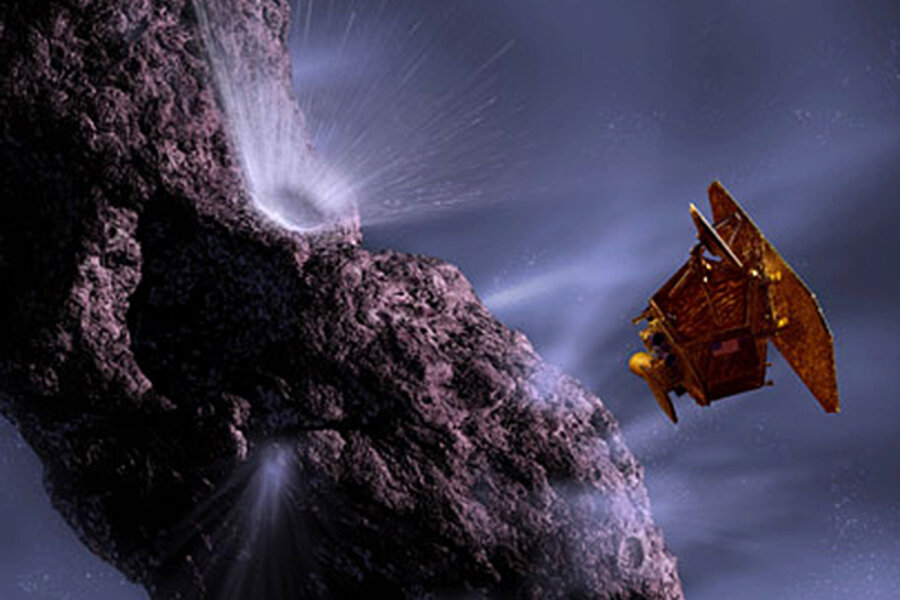Stardust-NExT to make Valentine rendezvous with comet Tempel 1
Loading...
A retread spacecraft is headed for a Valentine's Day tryst with familiar comment, the spud-shaped Tempel 1.
NASA's Stardust-NExT spacecraft is slated to flit by the comet at 11:37 Eastern Standard Time Monday night, passing within 120 miles of the object's nucleus – an encounter that researchers hope will unlock some of the object's secrets and complete some unfinished business there.
It won't be NASA's first visit to the comet. The Deep Impact mission, launched in January 2005, sent a projectile into the comet's surface during a flyby on July 4 of that year.
That mission revealed a comet that was "unusually interesting," says the mission's lead researcher, Joseph Veverka, a planetary scientist at Cornell University in Ithaca, N.Y.
Deep Impact beamed back images of a sculpted Tempel 1 nucleus hosting craters, long stretches of cliffs, sediment layering, and plateaus that look like debris flows.
Based on those images, researchers have gleaned that the comet "really has a geologic history; it's not just a fuzz ball" says Peter Schultz, a planetary scientist at Brown University and a member of both the Deep Impact and Stardust-NExT science teams.
And while Deep Impact's projectile slammed into the comet's surface as planned, the dust it kicked up obscured the crater it formed, preventing researchers from using the crater to better understand the structure of the nucleus and how firmly it's held together.
The Stardust-NExT team aims to get closer looks at these features in hopes of piecing together that history.
My how you've changed
Researchers want to compare images of the surface they gather with those beamed back from Deep Impact. The goal is to gauge the effects the comet's intervening travels have had on the nucleus.
And, if the craft and comet are oriented in just the right way, the crater generated by the Deep Impact projectile should be visible.
Tempel 1's nucleus is 4.7 miles long and 3 miles across at its widest point. The comet was discovered in 1867, but after several observations over the following 12 years, the comet seemed to vanish. It reappeared on astronomers photographic plates in 1967.
Astronomers traced Tempel 1's nearly century-long disappearance to changes Jupiter imposed on the comet's orbit.
Two close encounters with Jupiter toward the middle of the 20th century tweaked the comet's orbit again, giving it a return time of once every 5.5 years. The comet orbits the sun twice for every orbit Jupiter makes. And it moves from near Jupiter's orbit at its greatest distance from the sun to near the orbit of Mars as it swings behind the sun and heads back on its return trip.
The Stardust-NExT spacecraft has piled up mileage in it own right, logging some 3.7 billion miles since its launch as the Stardust mission in February 1999. Stardust sped through the cloud of dust and gas that surrounds the comet Wild 2 in January 2004, scooped up samples of the detritus, then headed back to Earth. As it sped past Earth in January 2006, it dropped off a capsule containing the samples, delivering the first pristine cometary material humans have ever had a chance to examine.
On to Tempel 1 ... again
That still left NASA with "a perfectly working spacecraft" and enough fuel to reach another target, Dr. Veverka says. With data from Deep Impact in hand, the team went to NASA and successfully pitched a plan to extend the mission to give comet Tempel 1 another look.
Since then, ground-based astronomers as well as researchers using the Hubble Space Telescope have been monitoring Tempel 1 to glean its rate of spin, frequently tweaked by the jets of gas it spews as it heads toward the sun and warms.
The goal is to predict an encounter time when the orientation of the nucleus with respect to the sun and to the spacecraft is most likely to "put the high-dollar real estate in sunlight facing the spacecraft at the flyby," explains Steven Chesley, a researcher at NASA's Jet Propulsion Laboratory in Pasadena, Calif., and one of the mission's scientists.
Fortunately, he says, Tempel 1 displays relatively easy-to-predict behavior, allowing the team to set up the spacecraft's rendezvous without having to make adjustments through fuel-costly maneuvers.
Whether controllers have set the mission up so the sun will shine where researchers hope it will remains to be seen.
If it turns out they miscalculated a bit, no worries, says Dr. Chesley.
"The alternative is not so bad. We'll get fantastic views of never-been-seen-before cometary terrain," he says.





